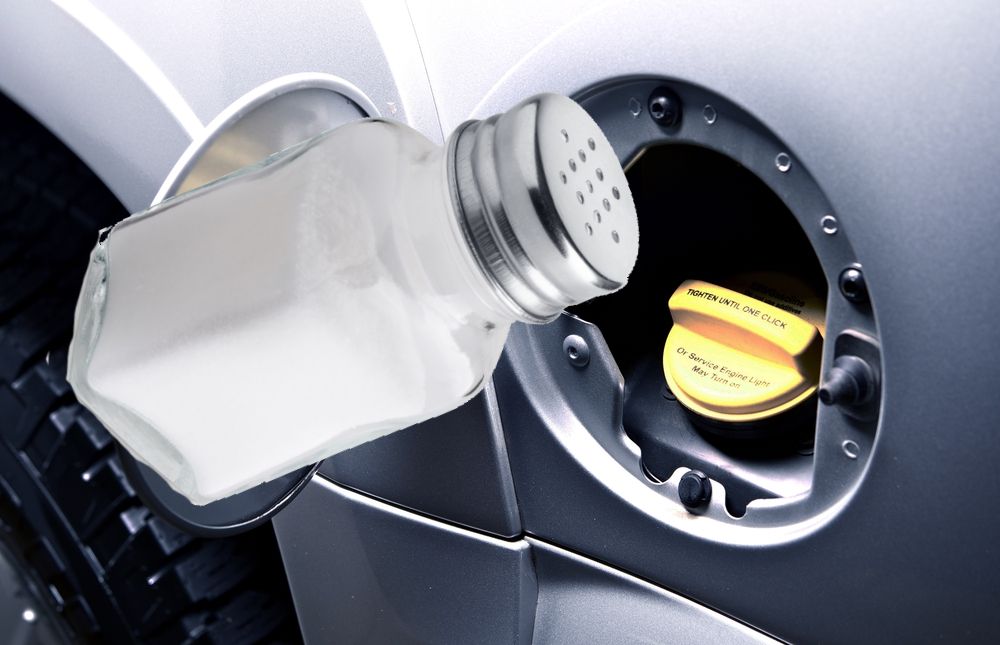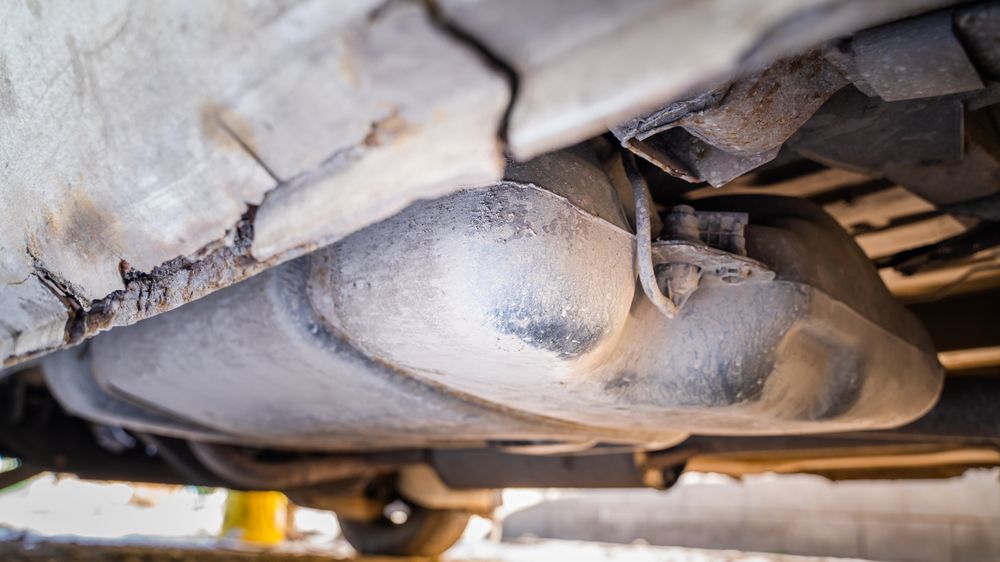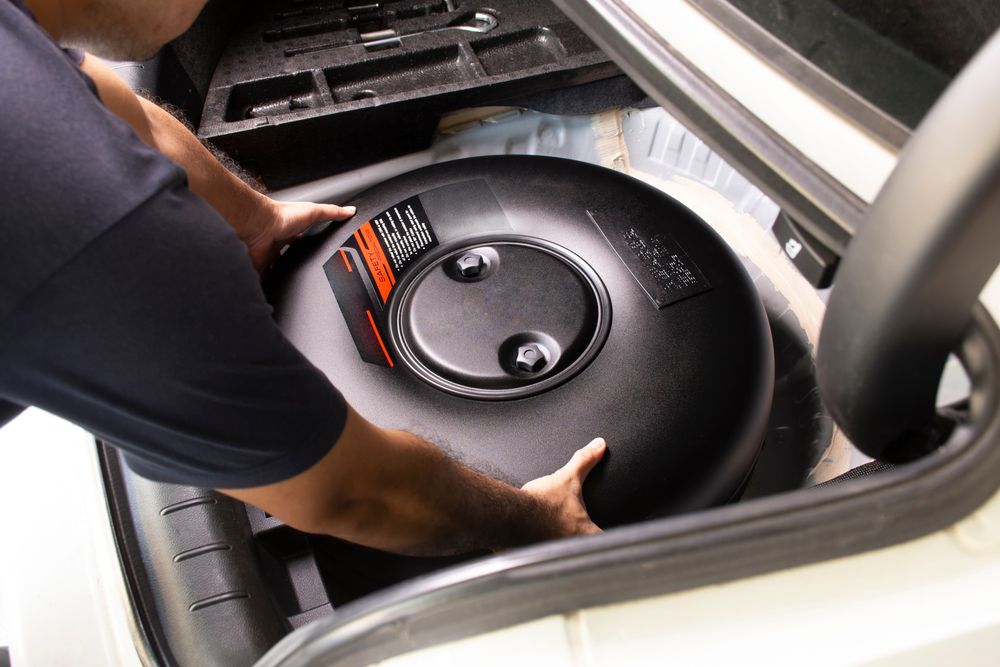The gas tank is an integral part of a car. It holds the gas to keep your
vehicle running while preventing the vapors of the highly flammable liquid
from escaping into the atmosphere.
This is why it is commonly targeted in car vandalism incidents.
People have had everything from sugar and sand to golf balls and other
foreign objects put inside their gas tanks, all causing various degrees of
damage to the engine.
But what happens if you put salt in a gas tank?
Since salt is insoluble in gasoline, it will remain in its granular form.
The salt particles will settle at the bottom of the tank, where, provided
the right conditions, they will corrode its metallic surface. The corrosion
can lead to damage and leaks which is a problem because gasoline is
expensive and highly flammable.
So what happens if there is salt in a gas tank? Let's take a look.
 Salt in gas tank can cause significant damage.
Salt in gas tank can cause significant damage.
What Will Salt Do To an Engine?
While it takes some time to do so, salt can cause serious damage and
possibly even destroy a car engine in the right circumstances.
Salt particles do not dissolve into gasoline and can trigger corrosion in
the various engine systems they come in contact with.
They can clog the fuel filter, cause fuel pump failure, and warp the
various engine parts, reducing their lifespan.
Salt in a gas tank has both immediate and delayed effects on your car and
its engine.
The short term effects are fixable, especially if you're able to detect its
presence early on. But if exposed over a long period of time, the damage
can be very extensive.
Corrosion
Corrosion is the most noticeable ill-effect of salt on a car's engine.
Since it is a highly abrasive and reactive substance, salt causes permanent
damage by corroding the metallic engine components.
The most likely place for corrosion from salt is in the car's gas tank.
Salt in your gas tank will immediately settle at the bottom since it is
heavy. And if it goes unnoticed, it will start reacting with the metal
surface of the tank and cause corrosion.
Over a long period of time, this corrosion will cause holes and leaks in
the tank, leading to fuel wastage and creating a fire hazard.
 Salt causes corrosion in a gas tank.
Salt causes corrosion in a gas tank.
Damages The Engine
Driving the car with salt in the gas tank may introduce the particles to
other engine components.
As the engine runs, the salt gets picked up by the fuel pump, which pushes
the granules through the vehicle's fuel lines, filter, fuel injectors, and
straight into the engine's combustion chamber.
If salt particles settle here or anywhere along the way, and have time to
react with these metallic parts, it will cause corrosion.
Besides corroding the engine parts and causing gas tank damage, salt can
also clog your fuel system. The tiny salt particles make their way to the
fuel filter and restrict the fuel's flow toward the engine.
With the filter clogged, the fuel injectors start acting up because they
cannot work as efficiently in such conditions. This can interfere with your
engine's performance and gas consumption as a clogged filter and injectors
could lead to an incorrect fuel-air mixture in the combustion chamber.
Your engine will run rough, start sputtering and your car will stall. If
you keep driving in such a situation, the car engine can seize up and fail
completely.
Warping And Friction
Salt also destroys the car engine by causing warping in its components. It
corrodes moving engine parts, such as pistons and crankshaft.
As a result, their smooth working surfaces become jagged which makes it
difficult for the parts to move together, and when you force them to move
together, these engine parts grind against each other, resulting in
premature wear and tearing.
Their resultant friction may also cause the entire system to heat up which
causes further warping in various engine parts.
Eventually, the warped parts will wear excessively and fail to function at
all.
 Mechanic removing a gas tank to remove salt.
Mechanic removing a gas tank to remove salt.
How Do You Tell If There is Salt in a Gas Tank?
Unfortunately, it is very difficult to tell if there is salt in a gas tank
unless you yourself put the salt there or saw someone else put it in your
gas tank. If you suspect that your tank is tampered with, you should take
your car to an auto repair shop or consult a gas tank professional for
advice.
While salt won't dissolve in the gasoline, it will quickly settle at the
bottom of your gas tank since it's heavier.
So, even if you try to look for it, you won't be able to tell whether the
salt granules are there or not. But that doesn't mean it is undetectable.
Any gas tank professional with a trained eye can quickly detect its
presence by disassembling the tank and inspecting the pump filter and fuel
filter for salt particles.
They can not only tell you whether someone has tampered with your gas tank,
they'll also offer you advice on how to get it out of your fuel system.
So, if you suspect there is anything wrong with your vehicle, you should
immediately take it to a mechanic shop and have the fuel tank and engine
checked for salt damage.
How to Remove Salt in a Gas Tank
If you believe that there is salt or any other foreign object inside your
gas tank, you should try to remove as much of it as possible.
Drain all the fuel from the gas tank and flush it with a cleaner for salt
deposits. If it has been there for long, you might want to replace the fuel
filter and pump as well.
As we already learned, having salt in a gas tank is very dangerous. If
there is salt, or any other foreign object, in your gas tank, you should
immediately remove it before it causes damage to your fuel tank and engine.
Here's how to do it:
1. Drain the Fuel Tank
Start by emptying your gas tank. We recommend using a proper manual pump
for gasoline. You can easily purchase one from your local auto parts store.
Pump the gas out into an approved container.
2. Apply a Cleaner For Salt Deposits
Next, get a good fuel system cleaner and apply it on the inside of the gas
tank. Since salt particles will be at the bottom, that should be your main
focus. Let it soak the tank for a few hours.
3. Rinse the Gas Tank With Water
Now rinse the gas tank with clean water. Using a power washer will help
dislodge any stubborn deposits.
4. Allow it to Dry
Let the gas tank dry completely — usually 24 to 48 hours before you fill up
the gas again.
It is also possible to go to a mechanic shop and have them remove the salt
from the gas tank.
Conclusion
Having salt in the gas tank is bad. It may need the right conditions to
start the damage, but salt can corrode and clog the internal parts of your
car.
If someone has put salt in your gas tank, you should immediately have an
auto mechanic remove it. Fail to do so, and the salt particles will corrode
your gas tank, clog your car's fuel system, damage its engine and cause it
to overheat. In worst case, your engine will fail.